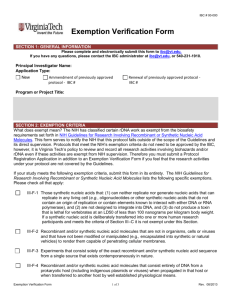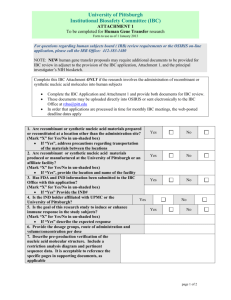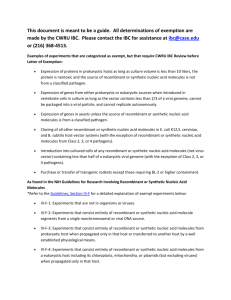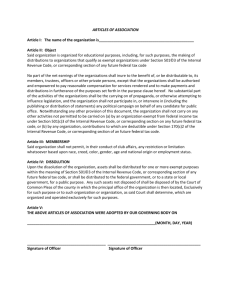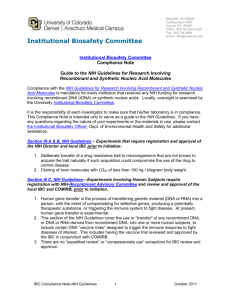Exempt Study Review Form for Research Involving Recombinant or
advertisement
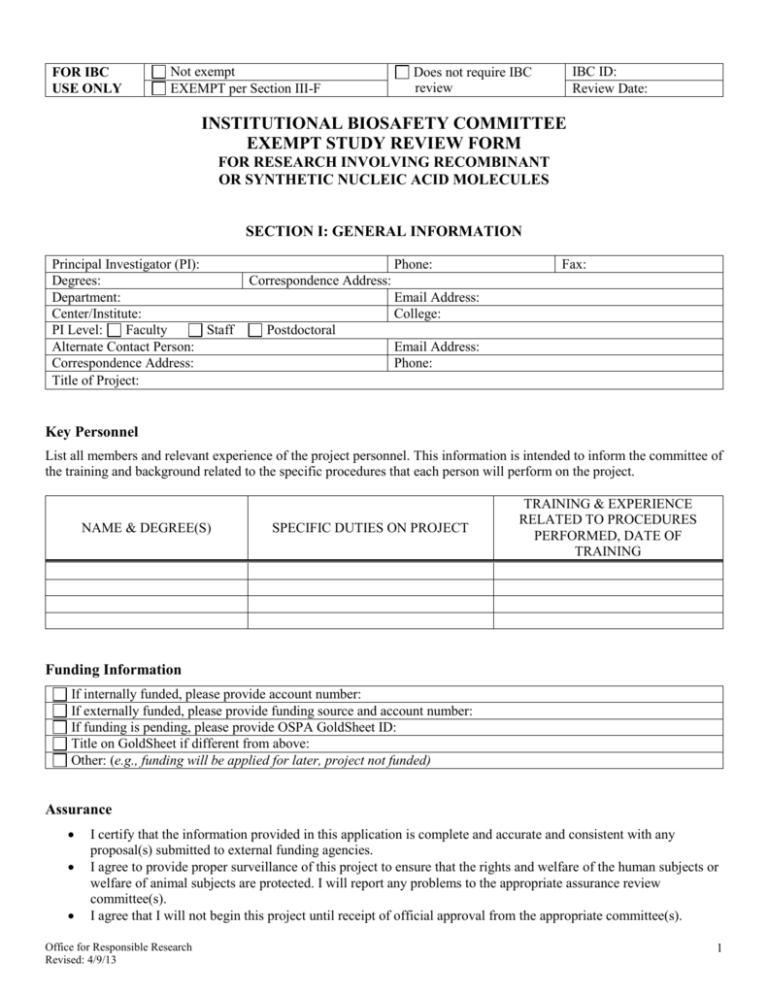
FOR IBC USE ONLY Not exempt EXEMPT per Section III-F IBC ID: Review Date: Does not require IBC review INSTITUTIONAL BIOSAFETY COMMITTEE EXEMPT STUDY REVIEW FORM FOR RESEARCH INVOLVING RECOMBINANT OR SYNTHETIC NUCLEIC ACID MOLECULES SECTION I: GENERAL INFORMATION Principal Investigator (PI): Degrees: Department: Center/Institute: PI Level: Faculty Staff Alternate Contact Person: Correspondence Address: Title of Project: Phone: Fax: Correspondence Address: Email Address: College: Postdoctoral Email Address: Phone: Key Personnel List all members and relevant experience of the project personnel. This information is intended to inform the committee of the training and background related to the specific procedures that each person will perform on the project. NAME & DEGREE(S) SPECIFIC DUTIES ON PROJECT TRAINING & EXPERIENCE RELATED TO PROCEDURES PERFORMED, DATE OF TRAINING Funding Information If internally funded, please provide account number: If externally funded, please provide funding source and account number: If funding is pending, please provide OSPA GoldSheet ID: Title on GoldSheet if different from above: Other: (e.g., funding will be applied for later, project not funded) Assurance I certify that the information provided in this application is complete and accurate and consistent with any proposal(s) submitted to external funding agencies. I agree to provide proper surveillance of this project to ensure that the rights and welfare of the human subjects or welfare of animal subjects are protected. I will report any problems to the appropriate assurance review committee(s). I agree that I will not begin this project until receipt of official approval from the appropriate committee(s). Office for Responsible Research Revised: 4/9/13 1 I agree that modifications to the originally approved project will not take place without prior review and approval by the appropriate committee(s), and that all activities will be performed in accordance with all applicable federal, state, local, and Iowa State University policies. SIGNATURES Signature of Principal Investigator Date Signature of Department Chair Date For IBC Use Only Project is exempt. Project is not exempt. Project does not require IBC review because: Signature of IBC Chair Office for Responsible Research Revised: 4/9/13 Date 2 SECTION II: EXEMPTION CATEGORY PLEASE NOTE: All procedures for all subjects in a project must be exempt in order for the project to be reviewed for exemption (i.e., all of the research activities must be found in one or more of the following categories). This form is to be used only for research that is found in Section III-F: Exempt Experiments and Appendix C: Generation of B11 Transgenic Rodents via Breeding of the NIH Guidelines for Research Involving Recombinant or Synthetic Nucleic Acid Molecules. If your research involves human, plant or animal pathogens, biological toxins, or administration of experimental biological products, you must complete either an “IBC Application Form” or a “Protocol Review Form – Research (combined IACUC and IBC application).” Investigators who complete the exempt form and whose research project involves procedures which do not fit within an exempt category will be asked to complete one of the forms noted above. If you have any question about the exempt categories and whether your study falls within the exempt category, we encourage you to contact the IBC Administrator for assistance (4-5412). If your study is declared exempt, you will not be required to submit the annual continuing review document. If any changes are made to the research project, you must submit a modification for a determination by the IBC as to whether the research remains exempt according to the NIH Guidelines. 1. Please explain why your study is exempt from the NIH Guidelines. 2. The following categories are eligible for exempt status review. Check all categories and sub-parts applicable to your research. To select a category box, double-click on the check box. Section III-F-1: Those synthetic nucleic acids that: (1) can neither replicate nor generate nucleic acids that can replicate in any living cell (e.g., oligonucleotides or other synthetic nucleic acids that do not contain an origin of replication or contain elements known to interact with either DNA or RNA polymerase), and (2) are not designed to integrate into DNA, and (3) do not produce a toxin that is lethal for vertebrates at an LD50 of less than 100 nanograms per kilogram body weight. If a synthetic nucleic acid is deliberately transferred into one or more human research participants and meets the criteria of Section III-C, it is not exempt under this Section. This form does not need to be filled out for synthetic nucleotides that are PCR primers or PCR products. Section III-F-2: Those that are not in organisms, cells, or viruses and that have not been modified or manipulated (e.g., encapsulated into synthetic or natural vehicles) to render them capable of penetrating cellular membranes. Section III-F-3: Those that consist solely of the exact recombinant or synthetic nucleic acid sequence from a single source that exists comtemporaneously in nature. Section III-F-4: Those that consist entirely of nucleic acids from a prokaryotic host, including its indigenous plasmids or viruses when propagated only in that host (or a closely related strain of the same species), or when transferred to another host by well established physiological means. Office for Responsible Research Revised: 4/9/13 3 Section III-F-5: Those that consist entirely of nucleic acids from a eukaryotic host including its chloroplasts, mitochondria, or plasmids (but excluding viruses) when propagated only in that host (or a closely related strain of the same species). Section III-F-6: Those that consist entirely of DNA segments from different species that exchange DNA by known physiological processes, though one or more of the segments may be a synthetic equivalent. A list of such exchangers will be prepared and periodically revised by the NIH Director with advice of the RAC after appropriate notice and opportunity for public comment (see Section IV-C-1-b-(1)-(c), Major Actions). See Appendices A-I through A-VI, Exemptions under Section III-F-6—Sublists of Natural Exchangers, for a list of natural exchangers that are exempt from the NIH Guidelines. Section III-F-7: Those genomic DNA molecules that have acquired a transposable element, provided the transposable element does not contain any recombinant and/or synthetic DNA. Section III-F-8: Those that do not present a significant risk to health or the environment (see Section IV-C-1b-(1)-(c), Major Actions), as determined by the NIH Director, with the advice of the RAC, and following appropriate notice and opportunity for public comment. See Appendix C, Exemptions under Section III-F-8 for other classes of experiments which are exempt from the NIH Guidelines. Appendix C-I, Recombinant or Synthetic Nucleic Acid Molecules in Tissue Culture—Introduction into tissue culture cells of any recombinant or synthetic nucleic acid molecules containing less than half of any eukaryotic viral genome Appendix C-II, Escherichia coli K-12 Host-Vector Systems—Cloning of DNA in E. coli Appendix C-III, Saccharomyces Host-Vector Systems—Cloning of DNA S. cerevisiae host-vector systems Appendix C-IV, Kluyveromyces Host-Vector Systems—Experiments involving Klyuveromyces lactis host-vector systems Appendix C-V, Bacillus subtilis or Bacillus licheniformis Host-Vector Systems—Cloning of DNA in B. subtilis or B. licheniformis host-vector Appendix C-VI, Extrachromosomal Elements of Gram Positive Organisms—Recombinant or synthetic nucleic acid molecules derived entirely from extrachromosomal elements of the organisms listed Note: The exemptions listed above do not apply to DNA from Risk Groups 3 and 4 pathogens. Appendix C-VII, The Purchase or Transfer of Transgenic Rodents—The purchase or transfer of transgenic rodents for experiments that require BL1 containment Will the animals be purchased from a commercial source? Yes No If “No,” how will the animals be obtained? Appendix C-VIII, Generation of BL1 Transgenic Rodents via Breeding—The breeding of two different transgenic rodents or the breeding of a transgenic rodent and a non-transgenic rodent with the intent of creating a new strain of transgenic rodent that can be housed at BL1 containment will be exempt if: Both parental rodents can be housed under BL1 containment, and Neither parental transgenic rodent contains the following genetic modifications: Incorporation of more than one-half of the genome of an exogenous eukaryotic virus from a single family of viruses; Yes No Or Incorporation of a transgene that is under the control of a gammaretroviral long terminal repeat (LTR); Yes No Office for Responsible Research Revised: 4/9/13 4 and The transgenic rodent that results from this breeding is not expected to contain more than one-half of an exogenous viral genome from a single family of viruses. Note: The exemptions listed above do not apply to DNA from Risk Groups 3 and 4 pathogens. SECTION III: PROTOCOL INFORMATION Study Objectives 1. Provide an overall summary of the project and briefly explain in language understandable to a high school student the specific aim(s) of the study. 2. Briefly explain the experimental design. Please describe the project with respect to use of recombinant DNA. 3. Please describe the source of the DNA, including the type of organism, species, strain, cultivar/cell line. 4. Please describe the nature of the inserted DNA sequences, including regulatory or coding region, entire genome, synthetic antisense sequences, etc. 5. Please describe the recipient organism(s) for the DNA. Specify the type of organism, species, strain, cultivar/cell line, origin, etc. 6. List vectors to be used, such as expression vectors, and briefly specify their purpose. 7. Yes No Will there be a deliberate attempt to express a foreign gene? If “Yes,” describe how expression of the inserted DNA sequences will result in differences from the non-modified parental organism (for example, morphological or structural characteristics, physiological activities and processes, growth characteristics). Indicate possible toxicity or other hazards, if any: Office for Responsible Research Revised: 4/9/13 5 SECTION IV: ENVIRONMENTAL HEALTH AND SAFETY Yes No Will this project involve any of the following: human cell or tissue cultures (primary OR immortalized), or human blood components, body fluids or tissues? If the answer is “Yes,” please proceed to Part A: Human Cell or Tissue Cultures. Part A: Human Cell or Tissue Cultures Yes No Will this project involve human cell or tissue cultures (primary OR immortalized cell lines/strains)? 1. Please list the specific cell lines/strains to be used, their source, and description of use. CELL LINE SOURCE DESCRIPTION OF USE Add New Row Yes No Have the human cell or tissue cultures been documented to be free of bloodborne pathogens? If “Yes,” please fax or attach copies of the documentation. If “No,” please complete this section. 2. Please refer to the ISU Bloodborne Pathogens Manual, which contains the requirements of the OSHA Bloodborne Pathogens Standard. Please list the specific precautions to be used for this project below (e.g., retractable needles will be used for blood draws): Anyone working with human cell lines/strains that have not been documented to be free of bloodborne pathogens is required to have Bloodborne Pathogen Training annually. Current Bloodborne Pathogen Training dates must be listed in Section I for all Key Personnel. Please contact Environmental Health and Safety (294-5359) if you need to sign up for training and/or to get a copy of the Bloodborne Pathogens Manual. Part B: Human Blood Components, Body Fluids or Tissues Yes No Will this project involve human blood components, body fluids or tissues? If “Yes,” please answer all of the questions in the Human Blood Components, Body Fluids or Tissues section. 1. Please list the specific human substances used, their source, amount, and description of use. SUBSTANCE E.g., Blood SOURCE Normal healthy volunteers AMOUNT 2 ml DESCRIPTION OF USE Approximate quantity, assays to be done. Add New Row Office for Responsible Research Revised: 4/9/13 6
